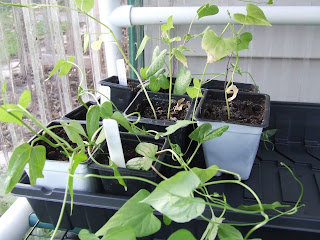Let's take one last look at gardening's black gold, compost. Several weeks ago, I told you that I would share with you the basics of starting a compost pile, and then I shared that the easiest way to compost is to get it from someone else. ;) We examined choosing the right site & creating a structure or purchasing a compost bin so that you can start adding material to your own compost pile this week.
Remember the quote I gave you last week... "Backyard composting is the intentional and managed decomposition of organic materials for the production of compost."(Tumbling Composter manual).
Now that we know what we can put into our compost pile, let's get 'intentional' and 'manage' the organic material we have collected so that we can put our pile to work making black gold for us. I've seen compost making compared to following a recipe in the kitchen and I think it is a great analogy. In the kitchen we follow a recipe so that we know exactly what the results will be and how quickly we can get the results. The same is true for composting. The difference lies in whom we will be serving. From the kitchen we serve our family and friends, but in the compost pile we are serving our garden friends the soil microbes and critters. :)
The compost recipe is a relatively simple one as it requires only four or five ingredients; brown organic material, green organic material, water, air and optional soil as innoculant. All of the four main ingredients are important in order for our recipe turn out the way we want it to. As in any recipe, too much or too little of any one ingredient may change the results of the recipe or how long it takes for the completion of the recipe. This being said, remember that the simplest compost pile is an uncontained pile of whatever brown or green organic material you have. If left completely unattended it will turn into compost in a year or so. Do not stress about getting everything perfect, it is important that composting not turn into a stressful job that you won't continue. There are too many positive benefits of having a compost pile to give up on it all together! Besides, I certainly do not have a perfect compost pile. In fact, one year I raised more ants (sign that it is way too dry) than food for garden friends in my compost pile. :}
Let us begin to put our recipe together...
Compost Recipe
75% brown organic material by volume
25% green organic material by volume
46-60% water content
air
optional - soil
Organic Material
Do you remember what made good brown and green organic material? Gather those materials up. You should have 75% brown organic material and 25% green organic material in your pile. Too much green material can make a smelly pile so if you question always add more brown. Layer those wonderful browns and greens like you are making lasagna. Remember that you are trying to get a 3:1 ratio. You could start by laying down 3 inches of leaves and dry lawn clippings with 1 inch of fresh lawn clipping and kitchen scraps on top. Repeat your layers until your pile is about 3 feet high or your compost bin is full.
Water
A damp (not wet!) pile decomposes the quickest. As you layer in your ingredients, lightly mist the dry materials. Remember that your green organic material contains its own moisture so it does not need added water. If you can grab a handful of material and squeeze water out of it, it is probably too wet and a pile is too wet it will begin to smell bad. The remedy is to add dry brown organic material and stir it up. If ants invade your pile, it has become too dry. Stick the water hose down inside the pile to get the interior wet and spray down the outside. You will need to water your pile every week or two if it is enclosed or you are having a dry spell.
Air
Like all living organisms, the soil microbes and critters that are laboring in the compost pile need air to survive. The pile will naturally settle and compress as the layers begin to break down. This will begin to suffocate the workers. Stir or fluff the pile with a garden fork or study stick every couple of weeks to maintain adequate air circulation.
Soil
To jump start your pile, add a sprinkling of garden soil every few layers. Garden soil is full of guests that will become valuable workers in the pile. :)
So, my fellow gardeners, we have spent a few weeks investigating how to create some black gold for soil improvement and fertilization in our gardens. I know I've learned a lot and I hope you have too. I have found the book, "The Frugal Gardener: How to Have More Garden for Less Money" by C. T. Erler especially helpful during this series along with the websites that I have referenced in The Pile and Compostable Material.
If you have any questions feel free to leave a comment or send me an email.
Happy (Compost) Gardening! :)
All Posts in the Composting 101 Series:
-Introduction
-Check Local Waste Management
-The 'Pile'
-My 'Piles'
-Compostable Material
-Maintenance
All Posts in the Composting 101 Series:
-Introduction
-Check Local Waste Management
-The 'Pile'
-My 'Piles'
-Compostable Material
-Maintenance










































